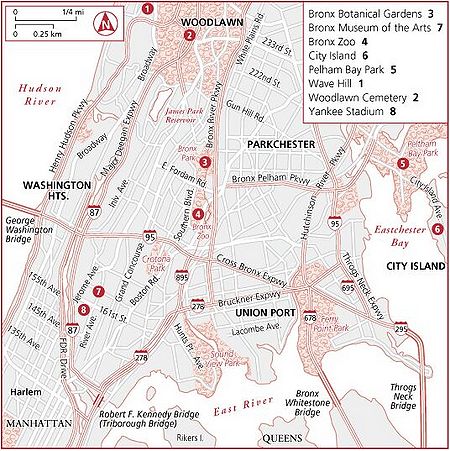The Bronx
 From Conservapedia
From Conservapedia The Bronx is a borough of New York City. It is the northernmost of the city's five boroughs, lying north of Manhattan from which it is separated by the Harlem River.

Contents
- 1 History
- 2 Favorite sons and daughters
- 3 See also
- 4 Movies set in the Bronx
- 5 External links
- 6 Further reading
History[edit]
The Bronx originally was part of Westchester County. In 1841, the New York and Harlem Railroad began regular commuter service between The Bronx and Manhattan, and by 1895 the area was detached from Westchester County and became parts of New York City. In 1898 it became one of the five boroughs. Transportation improvements allowed for rapid growth in the 19th century, involving the move from horse-drawn street cars to elevated railways to the subway system, which linked to Manhattan in 1904. The demographic history of the Bronx in the 20th century may be divided into four periods: a boom during 1900-29, with a population growth by a factor of six from 200,000 in 1900 to 1.3 million in 1930. Most residents were new immigrants from Europe or their children; about half the population was American Jews, most of the rest were Catholic (comprising German Americans, Italian Americans and Catholic Irish, along with many smaller groups).
The Great Depression and war years saw a slowing of growth during 1930-49. Many ethnic moved north into the Westchester suburbs, while the war years brought in large numbers of blacks from the South and the Caribbean, as well as Puerto Ricans.
The 1950s were hard times, as The Bronx decayed rapidly from a predominantly middle-class to a predominantly lower-class area with high rates of crime, poverty and despair. Finally The Bronx has enjoyed economic and demographic stabilization since 1980. By the 1920s the Fordham Road-Grand Concourse intersection was a great commercial nexus and a center of tree-lined avenues, with luxurious homes and apartment buildings designed in the latest Art Deco and modernist styles. Outstanding public attractions were the Bronx Zoo, one of the largest zoos in the world; the park-like New York Botanical Garden; the prestigious Bronx High School of Science; and Yankee Stadium, built in 1923, which gave way to a new stadium in 2009. In the 1970s the South Bronx became the iconic of America's urban crisis of unemployment and poverty during the 1970s, as arson in the city's public housing was a persistent symbol of the problem. However, led by aggressive community leaders, many burned-out tenements were replaced by single- and multifamily housing during the late 1970s to the present. Thus Co-op City began in 1968 as a subsidized, high-rise, middle-class housing project, whose tenants bought shares in the corporation that operated it. It succeeded because it delivered on its promise of economic affordability and controlled racial integration. By 2000 The Bronx had a population of about l.2 million and its bridges, highways, and railroads were more heavily traveled than those of any other part of the United States.
Favorite sons and daughters[edit]
General Colin Powell grew up in a poor Jamaican immigrant family in the Bronx before joining ROTC and then the Army. Supreme Court Justice Sonia Sotomayor grew up in a heavily Puerto Rican public housing unit; her mother worked double shifts as a nurse to send her to good Catholic schools. They spotted her talent and steered her to Princeton. The nation's first prominent Latina, she identified herself as a "kid from the Bronx."
See also[edit]
- New York City
Movies set in the Bronx[edit]
- Fort Apache: The Bronx
- A Bronx Tale
External links[edit]
- Museum of Bronx History
Further reading[edit]
- Jackson, Kenneth, ed. The Encyclopedia of New York City (1995), excerpt and text search
- Samtur, Stephen M. and Martin A. Jackson. The Bronx: Lost, Found, and Remembered, 1935-1975 (1999) online review, nostalgia
Categories: [New York City] [Urban History]
↧ Download as ZWI file | Last modified: 03/13/2023 21:53:49 | 65 views
☰ Source: https://www.conservapedia.com/The_Bronx | License: CC BY-SA 3.0
 ZWI signed:
ZWI signed: KSF
KSF